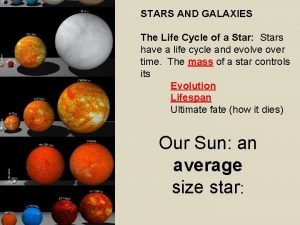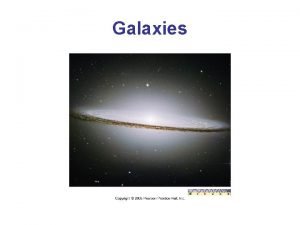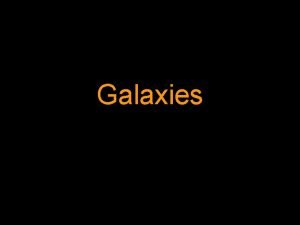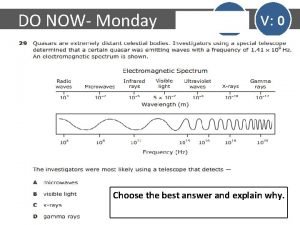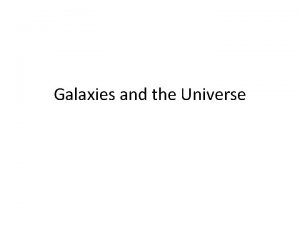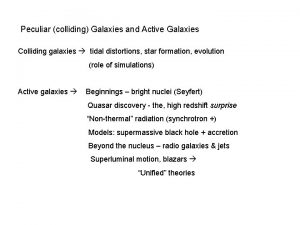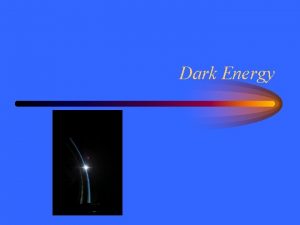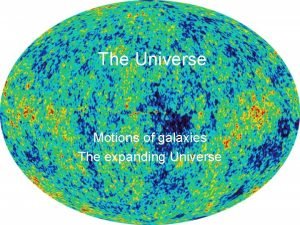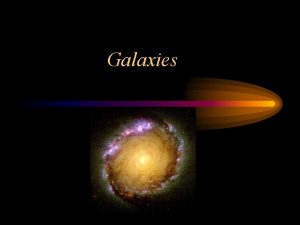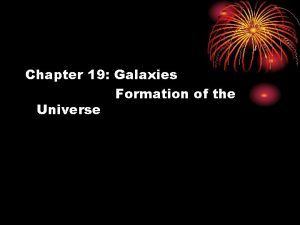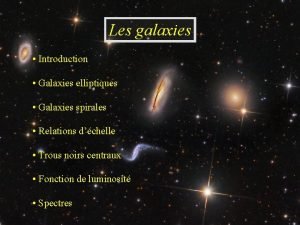GALAXIES AND THE UNIVERSE SECTION 4 GALAXIES A










- Slides: 10

GALAXIES AND THE UNIVERSE SECTION 4

GALAXIES A galaxy is a large group of stars, gas and dust held together by gravity.

SPIRAL GALAXIES Spiral galaxies are galaxies that have spiral arms the wind outword from the center. The Milky Way Galaxy is a spiral, as shown. Spiral galaxies can be normal or barred. In a Normal spiral Arms start close to the center of The galaxy. Barred spirals have spiral arms Extending from a large bar of stars and gas that passes through the center.

BARRED SPIRAL GALAXY

ELLIPTICAL GALAXIES These galaxies are shaped like large, three-dimensional ellipses. Many are football shaped. Some elliptical galaxies are small but some are so large that several galaxies the size of the Milky Way would fit inside them.

ELLIPTICAL GALAXY IN THE CONSTELLATION ANDROMEDA

IRREGULAR GALAXIES This third type of galaxy includes most of those galaxies that don’t fit into the other categories. Irregular galaxies have many different shapes. They are smaller than other types of galaxies. Two irregular galaxies called the clouds of Magellan orbit the Milky Way and the Large Magellanic Cloud. The Cloud of Magellan

THE MILKY WAY • Contains one trillion stars, but only about 100, 000 are visible. • It takes about 225 million years for the sun to orbit the center of the Milky Way • It is classified as a normal spiral galaxy, though some recent evidence suggests it might be a barred. Astronomers have limited data about how the galaxy looks from the outside. • All of the stars you see at night belong to the Milky Way. • Has a supermassive black hole at it’s center. This black hole might be more than 2. 5 million times as massive as the sun. • Part of the Local Group

DOPPLER SHIFT As you sit here, a star is moving toward the earth. It’s wavelengths of light are compressed, just as the sound waves from the train’s whistle are. This causes dark lines in the spectrum to shift toward the blue-violet end of the spectrum. A red shift in the spectrum occurs when a star is moving away from Earth.

RED SHIFT In 1929, Edwin Hubble published an interesting fact about the light coming from most galaxies. When a spectrograph is used to study light from galaxies beyond the Local Group, a red shift occurs in the light. What does tis red shift tell you about the universe? Because all galaxies beyond the Local Group show a red shift in their spectra, they must be moving away from Earth. If all galaxies outside the Local Group are moving away from the Earth, then the entire universe must be expanding.



